22 May 2014
Gentlemen:
At a recent auction, I purchased an early 250 model Charles Daly gun in 12-bore, circa pre-1891, with the following stamps underside the herringbone pattern “Manufacture Extra” damascus barrels: the serial number “298” on the right barrel flat; the country of origin, “SAXONY”, on the underside of each barrel alongside the ‘extension plate,’ forward of the barrel flats and lugs; immediately forward of the “SAXONY” country of origin stamp, and also located alongside the extension, the elder H. A. Lindner crown-over-crossed-pistols trademark; just forward of the edge of the extension plate are the barrel-maker’s initials, “LE”; located on the underside of the left barrel close by the under-rib; immediately across from the barrel-maker’s initials, there on the underside of the right barrel, and again close to the under-rib, are the numerals “444”.
There are neither proof house stamps or source of parts/materials marks whatsoever, nor stamps or marks other than the aforementioned, anywhere. Only the serial number, “298”, is repeated on the water-table, left side of the action bar bridge; floor of the rear lug bar slot; and stamped on the underside of the forearm iron, mid-iron.
Basic research and correspondence elsewhere informs me that the combination of “SAXONY”, crown-over-crossed-pistols trademark, and barrel-maker “LE” are comparatively uncommon, indeed quite rare. I have found but two other examples in the literature that bear SAXONY and crown-over-crossed-pistols stamps, but none where the preceding two are combined with barrel-maker “LE”, to my knowledge. Is this assertion correct, or matches your experience?
Who is barrel-maker “LE”, I wonder? I have seen a single W & C Scott hammer gun, presumably finished by Lindner, which bears that very stamp. Could “LE” be, like barrel-maker-filer “T. Kilby” (i.e. Thomas Kilby the Elder or his much younger relative, Thomas J. Kilby, who in the mid-1880s eventually took over the renowned company, maintaining its established name), yet another Briton sourced by the Prussians or Prussian Saxons? Or is he European? How rare or not are SAXONY-stamped Charles Daly hammerless guns? Where can this particular gun be placed as to its probable year of production?
In that respect, I think the gun's action and most of its constituent parts were completed before 1891 but the barrels, necessarily stamped with the country of origin because of being made after 1891, were then exported separately though concomitantly to the United States. I speculate that the second numeric series, or “444” in our example, may have been the result of a business strategy on the part of Schoverling, Daly & Gales that thought to export guns to the United States from abroad unassembled for import because of then prevailing import duties/tariffs, and then had them reassembled upon arrival somewhere in the United States. The numbers “444” and serial number “298” may have been associated one with the other in Prussia for inventory purposes, and ergo for the purpose of associative numbering and easier reassembly once in the United States.
Shown below (or click on the provided link) is an auction house photograph of the gun’s barrel flats, sans views of the barrel-maker’s initials and the numerals 444. The latter two mentioned stamps are not visible because they were formerly hidden by layers of grease and grime, since completely removed. Being 'camera-challenged' and possessed of a digital camera incapable of being focused on detail, I am unable at present to improve on the auction house’s photographs, with the exception of some of the following personal photographs not requiring fine detail.

The following photograph (or click on the provided link) is another produced by the auction house at my behest, which shows the condition of the Charles Daly gun at time of auction and its condition as received by me. The gun is noticeably covered with hardened, waxen appearing grime, which turned out to be layers of grease, whether axle or gun grease, mixed with neglectful decades of accumulated grime, darkly covering both metal and wood surfaces, front to end. Fortunately, these clogging and crystallized layers protected those very underlying surfaces they otherwise obscured and seemingly despoiled.
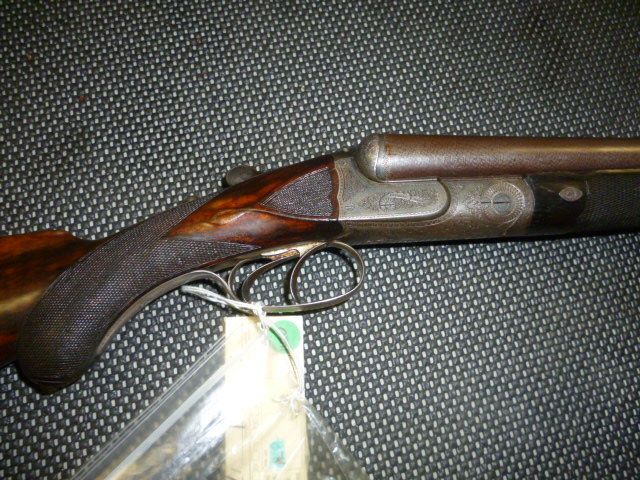
After many hours of cleaning metal and wood with judicious applications of mineral spirits, Hoppe’s No. 9, assorted soft-bristled toothbrushes, and stacks of clean cotton rags, I was afterwards able to produce roughly representative photographs of my newly cleaned Charles Daly gun, which are shown below (or click on the provided links). By the way, the 100% incredible color case hardening once uncovered appeared far, far brighter and deeper color-wise when the metal was simply lightly oiled; although as depicted here, the metal is dry. The cleaned wood you see will be sensibly, professionally restored, as will be the fine quality and largely undamaged damascus barrels (not depicted), the bores of which remain literally mirror bright. All the grease and grime and that clogging the chequering have been patiently and very carefully removed.
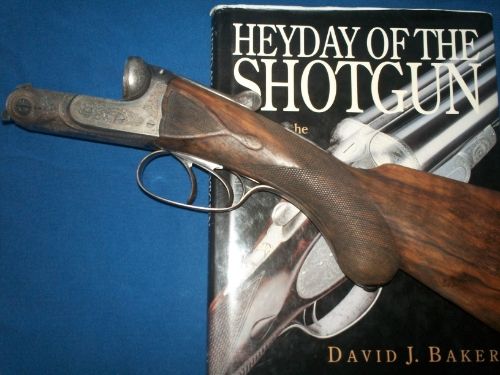
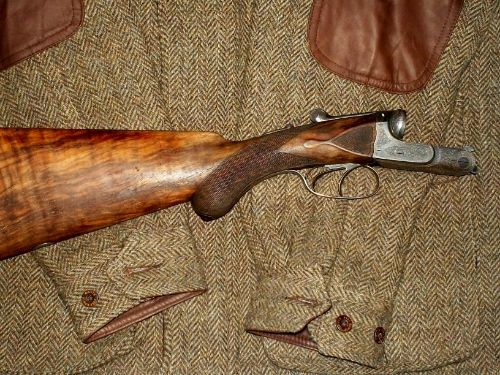
Thank you for whatever information or shared knowledge you care to provide, or comments you wish to make, any and all of which will be greatly appreciated. With my
Best regards,
Edwardian
Gentlemen:
At a recent auction, I purchased an early 250 model Charles Daly gun in 12-bore, circa pre-1891, with the following stamps underside the herringbone pattern “Manufacture Extra” damascus barrels: the serial number “298” on the right barrel flat; the country of origin, “SAXONY”, on the underside of each barrel alongside the ‘extension plate,’ forward of the barrel flats and lugs; immediately forward of the “SAXONY” country of origin stamp, and also located alongside the extension, the elder H. A. Lindner crown-over-crossed-pistols trademark; just forward of the edge of the extension plate are the barrel-maker’s initials, “LE”; located on the underside of the left barrel close by the under-rib; immediately across from the barrel-maker’s initials, there on the underside of the right barrel, and again close to the under-rib, are the numerals “444”.
There are neither proof house stamps or source of parts/materials marks whatsoever, nor stamps or marks other than the aforementioned, anywhere. Only the serial number, “298”, is repeated on the water-table, left side of the action bar bridge; floor of the rear lug bar slot; and stamped on the underside of the forearm iron, mid-iron.
Basic research and correspondence elsewhere informs me that the combination of “SAXONY”, crown-over-crossed-pistols trademark, and barrel-maker “LE” are comparatively uncommon, indeed quite rare. I have found but two other examples in the literature that bear SAXONY and crown-over-crossed-pistols stamps, but none where the preceding two are combined with barrel-maker “LE”, to my knowledge. Is this assertion correct, or matches your experience?
Who is barrel-maker “LE”, I wonder? I have seen a single W & C Scott hammer gun, presumably finished by Lindner, which bears that very stamp. Could “LE” be, like barrel-maker-filer “T. Kilby” (i.e. Thomas Kilby the Elder or his much younger relative, Thomas J. Kilby, who in the mid-1880s eventually took over the renowned company, maintaining its established name), yet another Briton sourced by the Prussians or Prussian Saxons? Or is he European? How rare or not are SAXONY-stamped Charles Daly hammerless guns? Where can this particular gun be placed as to its probable year of production?
In that respect, I think the gun's action and most of its constituent parts were completed before 1891 but the barrels, necessarily stamped with the country of origin because of being made after 1891, were then exported separately though concomitantly to the United States. I speculate that the second numeric series, or “444” in our example, may have been the result of a business strategy on the part of Schoverling, Daly & Gales that thought to export guns to the United States from abroad unassembled for import because of then prevailing import duties/tariffs, and then had them reassembled upon arrival somewhere in the United States. The numbers “444” and serial number “298” may have been associated one with the other in Prussia for inventory purposes, and ergo for the purpose of associative numbering and easier reassembly once in the United States.
Shown below (or click on the provided link) is an auction house photograph of the gun’s barrel flats, sans views of the barrel-maker’s initials and the numerals 444. The latter two mentioned stamps are not visible because they were formerly hidden by layers of grease and grime, since completely removed. Being 'camera-challenged' and possessed of a digital camera incapable of being focused on detail, I am unable at present to improve on the auction house’s photographs, with the exception of some of the following personal photographs not requiring fine detail.

The following photograph (or click on the provided link) is another produced by the auction house at my behest, which shows the condition of the Charles Daly gun at time of auction and its condition as received by me. The gun is noticeably covered with hardened, waxen appearing grime, which turned out to be layers of grease, whether axle or gun grease, mixed with neglectful decades of accumulated grime, darkly covering both metal and wood surfaces, front to end. Fortunately, these clogging and crystallized layers protected those very underlying surfaces they otherwise obscured and seemingly despoiled.

After many hours of cleaning metal and wood with judicious applications of mineral spirits, Hoppe’s No. 9, assorted soft-bristled toothbrushes, and stacks of clean cotton rags, I was afterwards able to produce roughly representative photographs of my newly cleaned Charles Daly gun, which are shown below (or click on the provided links). By the way, the 100% incredible color case hardening once uncovered appeared far, far brighter and deeper color-wise when the metal was simply lightly oiled; although as depicted here, the metal is dry. The cleaned wood you see will be sensibly, professionally restored, as will be the fine quality and largely undamaged damascus barrels (not depicted), the bores of which remain literally mirror bright. All the grease and grime and that clogging the chequering have been patiently and very carefully removed.


Thank you for whatever information or shared knowledge you care to provide, or comments you wish to make, any and all of which will be greatly appreciated. With my
Best regards,
Edwardian

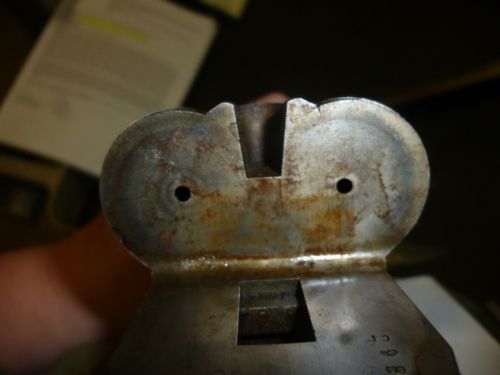
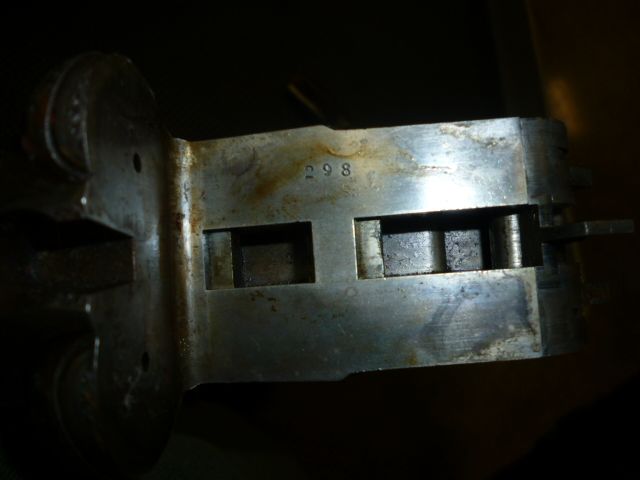
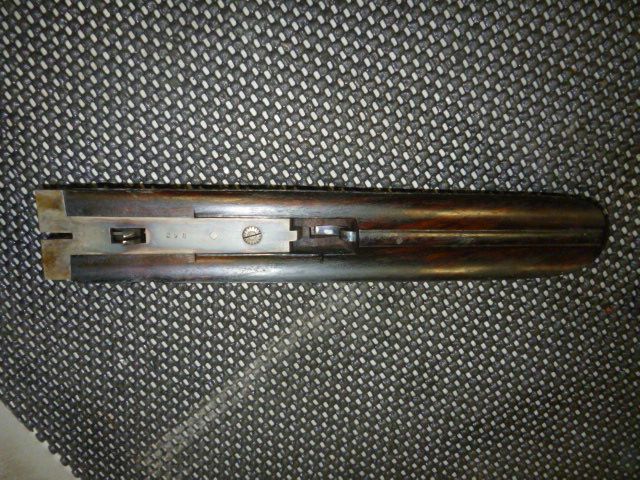


Comment